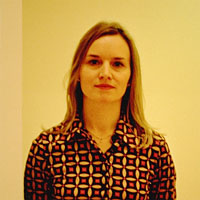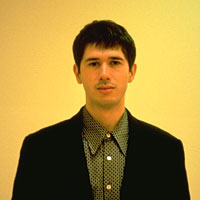|
|
|
||||||
|
|
|||||||
|
Since attracting public attention for their 1993 work <<Interactive Plant Growing>>--created during their term as graduate students at Institute for New Media, Städelschule, Frankfurt--Christa SOMMERER and Laurent MIGNONNEAU have been recognized for their series of highly-acclaimed interactive art installations. These works, which have been presented one after another, thematize the mutual interactions of humans and other forms of life and their ecosystems, and the communication between humans that such systems evoke. Key concepts of SOMMERER and MIGNONNEAU's works are interactivity, communication, virtual reality, and artificial life (A-Life). |
 Christa SOMMERER  Laurent MIGNONNEAU |
|
|
The most striking characteristic of SOMMERER and MIGNONNEAU's work is the depth of their inquiry into the relations between nature and human life; one might even call it the depth of their affections. Their works have cultivated a new A-Life art genre: not only by virtue of the works' interfaces, which take the form of natural elements such as plants and water; but perhaps, even more through the way in which the development and growth of virtual life are brought about by the interaction of humans and nature; not to mention the artists' ability to take into account unquantifiable elements--such as the emotions, moods, and capriciousness of humans and nature. Rather than being about the breeding of life inside a computer, SOMMERER and MIGNONNEAU's approach concerns the act of realizing a natural form of communication (for example, that of touch) between humans and other living things (including virtual creatures), an act that inevitably takes the form of interactivity. SOMMERER and MIGNONNEAU's work <<Interactive Plant Growing>> will undoubtedly be inscribed as a major work within the history of interactive art. In this work, exhibition visitors stretch their hands out toward a group of potted plants, or touch the plants; images of virtual plants appear and grow on the projection screen in response. The special feature of this work is the high quality of the human interface design employed. It doesn't make the exhibition visitor conscious of the fact that this interaction is mediated by a computer. The human interface design allows the work to maintain its thematic consistency from beginning to end and actualizes a real-time correspondence between actual and virtual space.
Another representative work of SOMMERER and MIGNONNEAU's, <<A-Volve>> (1993-94), engages the imagination of the visitor in a more direct manner than <<Interactive Plant Growing>> , and at the same time, imposes a responsibility. Sketches drawn on a computer touch-screen are transformed into virtual life forms that swim out into a pool of water. In correspondence to the bio-force and velocities that originate within these creatures, struggles for continued existence unfold in the tank. By sticking a hand into the pool itself, the exhibition visitor can further interact with these virtual life forms by catching them or protecting them. Those forms of life that come to triumph produce offspring that inherit the traits of their parents. While bringing biological conformity to bear upon ecological as well as hereditary algorithms, SOMMERER and MIGNONNEAU's works use high-level virtual reality technology to create a user-friendly interface. SOMMERER and MIGNONNEAU are especially skillful at coordinating in this work the sense of touch, an aspect of virtual reality that is hard to manipulate. Their 1994 work <<Phototropy>> uses an ordinary flashlight as an interface to provoke an interaction between the exhibition visitors and a group of virtual butterflies.
SOMMERER and MIGNONNEAU's installation <<Gemma>>, which was shown at the Ars Electronica '96, differs slightly from their earlier works in that it foregrounds the system by which exhibition visitors interactively design forms of life. By operating a menu, the visitor can design the features of various kinds of digital creatures. In the jet-black space of the screen, images of three-dimensional creatures are projected, creatures whose forms are imaginary, yet within the realm of imagination. These virtual living creatures are created by selecting attributes such as body segmentation, the number or position of their "feelers," or color and pattern. These creatures then move according to the design choices made, which are combined with a series of calculations to create the dynamism of their movement. As can be said of almost all of SOMMERER and MIGNONNEAU's work, this installation stunningly maintains a balance between its conceptual and empirical aspects.
(KUSAHARA Machiko)
|
||